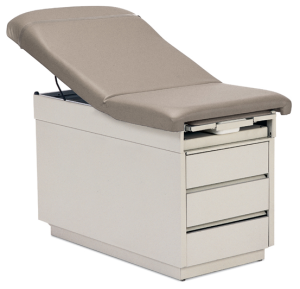 If patients can sit in chairs for hours in the waiting room, then they can sit in chairs inside the emergency department.
If patients can sit in chairs for hours in the waiting room, then they can sit in chairs inside the emergency department.
Only the very sickest patients should get defined care spaces with stretchers.
Over 85% of emergency patients get sent home. They do not need stretchers. Even some patients who need admission do not need a stretcher.
Keep vertical patients vertical and moving.
Emergency departments will never excel with the wrong furniture.
This post/podcast highlights the key ideas from Step 4 in my book: No More Lethal Waits: 10 Steps to Transform Canada’s Emergency Departments.
Use Chairs and Exam Tables, Not Stretchers
Stretchers can be numbered. They are finite, ‘safe’, mobile, and locatable. Stretchers foster rigid thinking. They support rigid nurse to patient ratios.
Stretchers attract admitted patients like watermelons produce fruit flies the next day.
Physical exams should occur on exam tables, in private. Patients can sit in chairs with their IVs. They can shuttle off to x-rays, or wait for blood work, from chairs.
You do not need to force patients into stretchers. Even patients with chest pain can spend most of their time in the ED on a chair.
Exam tables
- do not have wheels, so you cannot move patients around on them.
- have paper, not sheets, so physicians can change an exam table quickly without waiting for house cleaning.
- have no sides making it unsafe for patients to stay on them unattended.
- have hard surfaces that make them uncomfortable beyond brief exams.
Admitted patients cannot be admitted on to a exam table.
Exam tables are never full. They are a shared resource, whereas patients ‘own’ their stretcher for the whole ED visit.
Exam tables force patients to get up and move.
Exam tables are like operating room tables. No one ever admits a patient to an operating room table. OR tables are used only when staff are present.
Stretchers attract admitted patients, act like real estate, encourage patients to remain immobile, and allow patients to be tucked in safe and sound.
Emergency departments need exam tables everywhere, not just in the fast track/minor treatment areas.
Mental Furniture
Emergency departments need the right mental furniture.
Inpatient thinking harms patients.
On the wards, delay is good; waiting often helps patients get better.
- Sick patients want extra time.
- It’s compassionate and polite to go slowly.
- Waiting for tomorrow never causes harm.
- Sending people home just creates more work.
- Hasty decisions are often wrong.
- Delay rarely kills a patient after a diagnosis has been made.
But it’s opposite in EM care.
- Delay harms patients.
- Decreased length of stay (sending patients home) decreases work.
- Spending 40 minutes on compassionate care, or counselling, robs clinical services from people waiting for care.
Teams need an attitude of ‘get it done now’.
They need to pursue quality, capacity, and service in a way that fits with an emergency medicine mindset.
We need to be radically committed to service.
Emergency providers are always on, in the spotlight. We need to treat diaper rashes with as much sensitivity as trauma.
Patients determine the validity of a complaint, not providers.
There are no undeserving patients.
If teams are allowed to consider some patient concerns as minor, or a reflection of poor self care, it will poison the attitude required to serve.
We need to lose our arrogance and stoop to help every time.
You will find more in the book, but this gives a sense of Step 4 – Use Chairs and Exam Table, Not Stretchers, in No More Lethal Waits: 10 Steps to Transform Canada’s Emergency Departments.
photo credit: hamiltonmed.com
